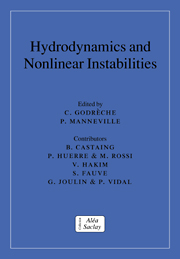Book contents
- Frontmatter
- Contents
- Preface
- Contributors
- Overview
- 1 An introduction to hydrodynamics
- 2 Hydrodynamic instabilities in open flows
- 3 Asymptotic techniques in nonlinear problems: some illustrative examples
- 4 Pattern forming instabilities
- 5 An introduction to the instability of flames, shocks, and detonations
- Index
5 - An introduction to the instability of flames, shocks, and detonations
Published online by Cambridge University Press: 04 November 2009
- Frontmatter
- Contents
- Preface
- Contributors
- Overview
- 1 An introduction to hydrodynamics
- 2 Hydrodynamic instabilities in open flows
- 3 Asymptotic techniques in nonlinear problems: some illustrative examples
- 4 Pattern forming instabilities
- 5 An introduction to the instability of flames, shocks, and detonations
- Index
Summary
Introduction and overview
Flames, shocks and detonations are phenomena of the traveling-wave type that are frequently encountered in the course of combustion processes. They can all be characterized as rather thin, interface-like regions, across which the properties of the fluid into which they travel undergo rapid changes.
Before introducing them it is perhaps worth devoting a few words to combustion itself. As is widely known, combustion intervenes in many instances of daily life (cars, heating, cooking) and in numerous industrial or accidental situations (engines, furnaces, fires…); gaining insights into its intricacies may therefore be useful to better monitor appliances or for safety purposes. No less importantly, combustion science involves enough mechanisms and peculiarities to please the scientist; it may indeed be defined as that of “exothermic chemical reactions in flows with heat and mass transfer” (Williams, 1992). More precisely, the laws governing combustion, a set of equations with a nonnegligible size, contain no less than the many interplays between nonisothermal chemistry, turbulence, compressible fluid mechanics, diffusive transports, buoyancy…, each of these being a serious subject of its own, not to speak of radiative transfer and multiphase media, which we shall deliberately ignore here.
This obviously opens up an extremely rich field of investigations, as witnessed by the size of recent treatises that offer a rather broad coverage of this field (Williams, 1985; Zel'dovich et al., 1985), or by the mammoth volumes which report regularly on the domain (e.g., see Combustion Institute, 1990).
- Type
- Chapter
- Information
- Hydrodynamics and Nonlinear Instabilities , pp. 493 - 674Publisher: Cambridge University PressPrint publication year: 1998
- 6
- Cited by



